Good Carbs for a Low Carb Diet
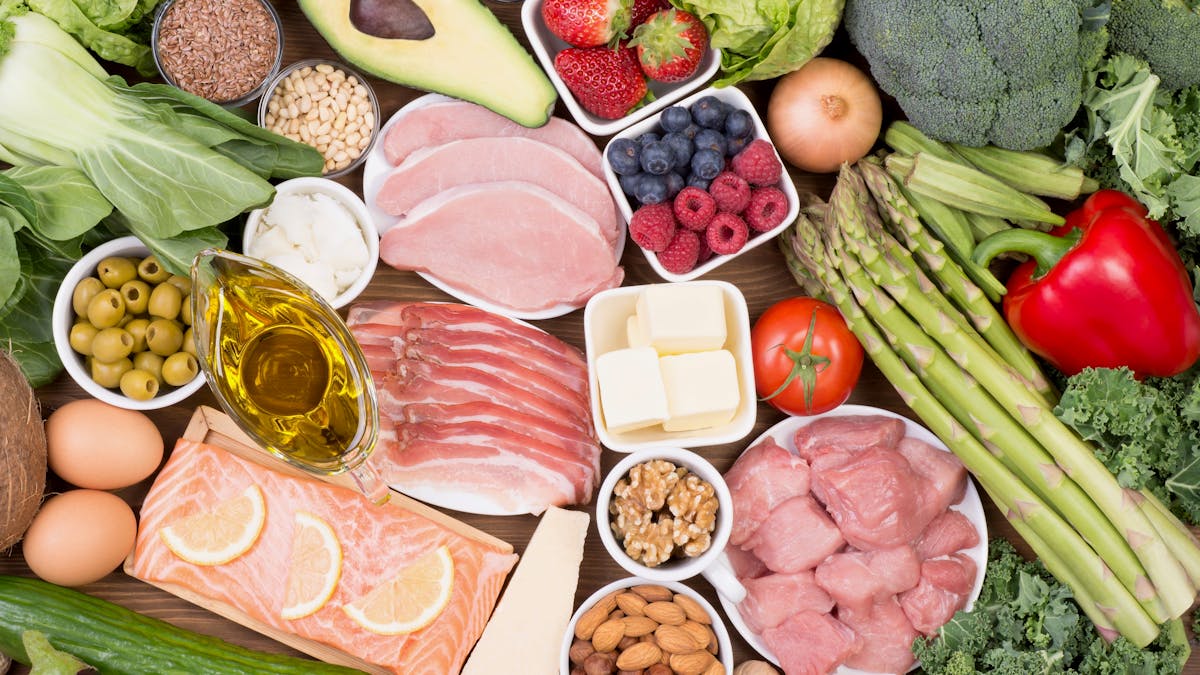
Low-carb foods
– what to eat
- Foods to eat
- Foods to avoid
- Printable leaflet
- Breakfasts
- Meals
- Snacks & desserts
- Bread
- Q&A
Low-carb foods include meat, fish, eggs, vegetables and natural fats, like butter.1 It's possible to eat delicious real food until you are satisfied… and still lose weight.2
On this page, you can learn how to make low carb simple. You get a guide to what to eat and what to avoid. You can also use our 1,000+ awesome low-carb recipes and our free 2-week get started challenge.
Visual low-carb guides
1. Low-carb foods list
Foods to eat
- Meat: Any type: Beef, pork, lamb, game, poultry, etc.3 Feel free to eat the fat on the meat as well as the skin on the chicken.4 If you can afford it, you may want to consider organic or grass-fed meats, although whether this has any significant health benefit is controversial, and scientific findings are still preliminary.5 Top meat recipes
- Fish and seafood: All kinds: Fatty fish such as salmon, mackerel, sardines or herring are great, and might even have health benefits due to high amounts of omega-3 fatty acids.6 Avoid breading. Top fish recipes
- Eggs: All kinds: Boiled, fried, scrambled, omelets, etc. You may want to choose pasture raised eggs, if possible.7 Top egg recipes
- Natural fats and high-fat sauces: Using butter and cream for cooking can make your low-carb foods taste better. Try a Béarnaise or Hollandaise sauce. If purchased pre-made, check the ingredients for starches and vegetable oils. Better yet, make it yourself. Coconut fat or olive oil are also good options.8 Learn more
- Vegetables that grow above ground: Cauliflower, broccoli, cabbage and Brussels sprouts, kale, collards, bok choy, spinach, asparagus, zucchini, eggplant, olives, mushrooms, cucumber, avocado (technically a fruit but usually included with vegetables), onions, peppers, tomatoes, lettuce, other kinds of leafy greens etc. These are lowest in net carbs and can be enjoyed at all levels of carb restriction. However, if you are following a keto diet (< 20 grams of carbs per day), you may need to limit your portions for certain types, like bell peppers and Brussels sprouts. Low-carb vegetables guide
- Dairy products: Feel free to choose full-fat options like real butter, cream (40% fat), sour cream, Greek/Turkish yogurt and high-fat cheeses, which can help you enjoy delicious food while losing weight.9 Be careful with regular milk, reduced fat and skim milk as they contain a lot of milk sugar.10 Avoid flavored, sugary and low-fat products.
- Nuts: Great for a treat (in moderation) instead of popcorn, candy or chips.11 Learn more
- Berries: Okay in moderation, if you do not need to be super strict with carbs. Great with whipped cream. Learn more
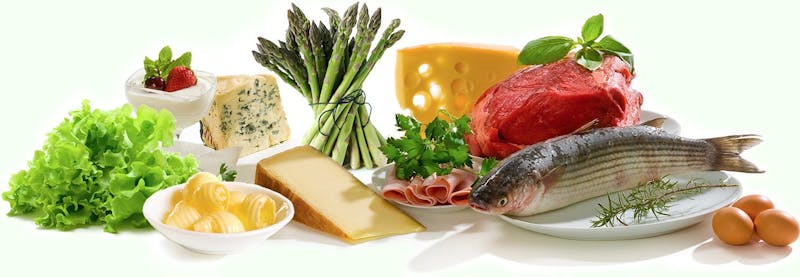
Read the nutrition label in the grocery store.
No more than 5% of carbohydrates in any food item is a good rule of thumb.
![]()
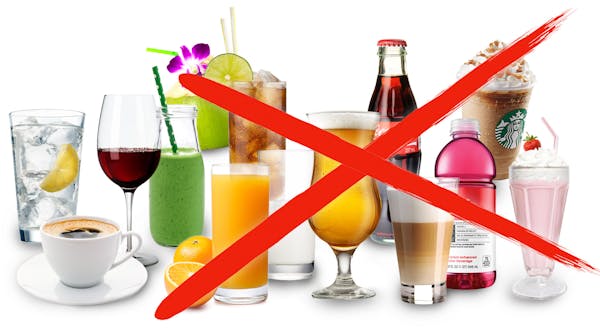
Drink
- Water – Try to make this your drink of choice, flavored or sparkling water is fine too, but be sure to read the ingredients list to check for added sugars. Alternatively look at the carbs section on the nutrition label.
- Coffee – Black or with small amounts of milk or cream is ideal for weight loss.12 Beware of adding lots of milk or cream, especially if you drink coffee regularly throughout the day, even when you're not hungry.13 But if you are hungry and need extra calories, feel free to use full-fat cream. Or try it with coconut oil and butter – "Bulletproof coffee".14
- Tea – The information for coffee above applies to tea too.
- More options in our full low-carb drinks guide
Recipes
For ideas and inspiration for appetizing meals that we think you and your family will love, take a look at our more than 1,000 low-carb recipes. Every week, we add more. Some of the most popular recipes you will find below, but we have recipes to suit almost every taste.

Special events
Invited out? Celebrating? You don't have to derail your diet. While too much celebrating can slow down weight loss, after a special event, just get right back to the diet and progress will resume.15
- Alcohol: You can drink in moderation dry wine, champagne or sparkling wine (extra dry or brut), whisky, brandy, vodka and gin.16 Vodka and soda water with a wedge of lime makes a great crisp drink. See our guide to alcoholic beverages.
- Dark chocolate: Above 70% cocoa, preferably only in small amounts.17 Full low-carb snacks guide

2. Do not eat high-carb foods
-
 Sugar: The worst choice, period.18 Soft drinks, candy, juice, sports drinks, chocolate, cakes, buns, pastries, ice cream, breakfast cereals – avoid them all. Although controversial based on scientific definitions, many find sugar to have addictive properties. Read our complete guide to sugar
Sugar: The worst choice, period.18 Soft drinks, candy, juice, sports drinks, chocolate, cakes, buns, pastries, ice cream, breakfast cereals – avoid them all. Although controversial based on scientific definitions, many find sugar to have addictive properties. Read our complete guide to sugar Preferably avoid or limit artificial sweeteners as well19 (here's why). Check out our full low-carb sweeteners guide
-
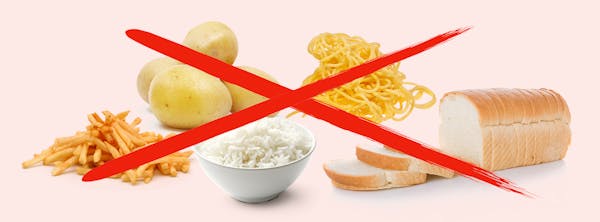 Starch:
Starch: Flour, wheat products or other refined cereal grains, even if labelled "gluten free."20 This means bread, buns, pasta, crackers, porridge, muesli. Whole grains are included here too – on a low-carb diet they are just less bad.21 Also potatoes (sweet potatoes too), potato chips, French fries, corn products and popped corn, rice. Do check out, however, some of the low-carb versions of these foods:
– Low-carb bread
– Low-carb "mashed potatoes"
– Low-carb "rice"
– Low-carb porridge
– Low-carb "pasta"Beans and lentils are also relatively high in carbs, so they're not good low-carb options. Moderate amounts of certain root vegetables may be OK (unless you're eating extremely low carb).
- Beer: Made from fermented grain and hops, beer is basically bread in liquid form. We recommend avoiding it altogether. Lower-carb beers (typically called "lite beer" in the US) are available, but keep in mind that they still contain more carbs than dry wine or pure liquor.
- Fruit: While berries like blueberries, raspberries and strawberries are fine in small to moderate amounts, be careful with other fruit. They are fairly high in carbs and sugar, which can raise blood sugar, may slow down weight loss and can possibly worsen metabolic issues.22 Consider it nature's candy: fine for a special treat, but probably not something to consume daily on a low-carb diet.23 Learn more
View list of things you may want to clean out from your pantry
Watch out
Be very skeptical of special "low-carb" products, such as pasta or chocolate. Unfortunately these products often work poorly and may have prevented weight loss for many people.24 They're often full of carbs once you see through the creative marketing.
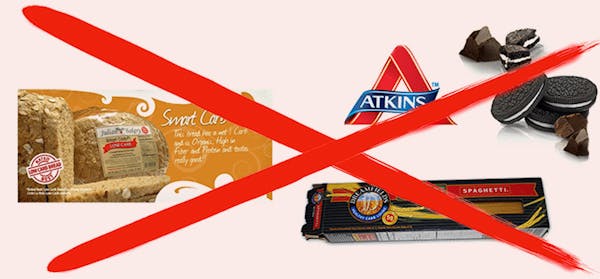 There are many companies that use deceptive advertising to entice you into buying their "low carb" products that are full of starch, flour, sugar alcohols and other sweeteners, and strange additives.25
There are many companies that use deceptive advertising to entice you into buying their "low carb" products that are full of starch, flour, sugar alcohols and other sweeteners, and strange additives.25
One of the largest of such companies was fined 8 million dollars for lying about the carb content of their products.
Two simple rules to avoid this junk:
- Don't eat "low carb" versions of high-carb stuff – like cookies, bars, chocolate, bread, pasta or ice cream – unless you are SURE of the ingredients (ideally by making it yourself).
- Avoid products with the words "net carbs" on them. That's usually just a way to fool you, and they are rarely good low-carb foods.
Read more about fake low-carb products
Also, preferably avoid margarine. It's a solid form of industrial seed and vegetable oils that contains trans fats. Why eat imitation butter when real butter is probably tastier and better for you?26
Learn more about vegetable oils
3. Make it real

Eat high-quality, minimally-processed low-carb foods.27 Shop the rim of the store and avoid packaged goods. Buy at local farmers' markets. No list of ingredients? Great. That means it's not processed.
A good strategy is to eat only low-carb foods that were available hundreds or even thousands of years ago. If it has a long list of ingredients and words on its label you've never heard of, don't eat it.
Handy brochure
Take this simple print-out-guide of which low-carb foods to eat and which to avoid to the store, or give it to interested family and friends.
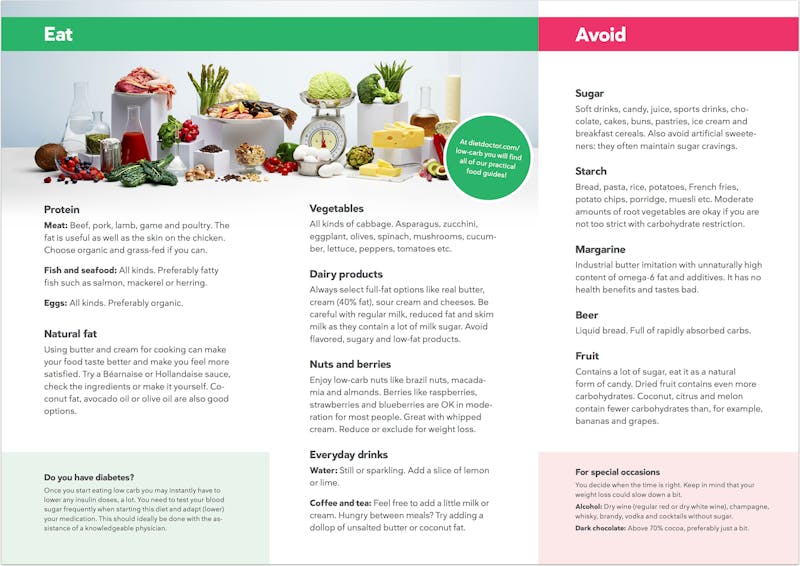
How low to go?
How many grams of carbs can you eat in a day and still be low carb? Many people on the Standard American Diet (SAD) consume more than 250 to 350 grams of carbs a day.28 So when you adopt a low-carb diet, anything below about 100 grams a day — especially if you cut out added sugars — may reap weight loss and metabolic benefits.29
However, the more weight you want to lose, or the more your health has suffered on the SAD way of eating, the fewer carbs you may want to consume at the start of the low-carb, high-fat diet.30 If you stay under 20 grams of carbs a day, you will be eating a very low-carb diet or ketogenic diet, in which your body converts from burning carbs (glucose) to burning fat and ketones for fuel.31 Ketogenic diets can also suppress appetite, so you end up eating less without getting hungry.32
Learn more about the ketogenic diet.
Some people can do very well consuming slightly more carbs — about 30 to 50 grams a day — as long as those come from healthy real low-carb foods, devoid of added sugars or refined carbohydrates. As well, once people reach their weight loss or health goals, some find they can add a few more carbs back into their diet from time to time.33
You may need to experiment to see where you feel your best and are able to easily maintain your weight and control cravings.34 Many people find that if they add back in carbs, their cravings for higher carbohydrate foods return.35
Here are three visual examples of various levels of carbs on a dinner plate. Learn more about how to determine the right amount of carbs for you.
Important: Don't fear fat!
After years of being told to avoid fat and eat low-fat foods, many people find the hardest part of adopting the diet is adding back in more fat. A low-carb diet needs fat, especially in the begining. Fat adds taste and calories. Get it from using butter, coconut oil, high fat cheese, olive oil, avocado oil, even beef and bacon fat. Just don't overdo it, since eating too much fat can prevent you from burning your stored body fat. Here are some easy tips.
Like a hybrid car engine, the body can burn two fuels for its energy needs. 1) glucose, from the breakdown of carbohydrates and 2) fats.37 When you are no longer consuming a lot of carbs, the body's engine will convert to burning fats.38 It will either burn the fat you have eaten or the fat stored on your body in your adipose tissue (e.g. belly fat).
The body will only switch to fat as the primary fuel when its carb supply is low. The diet is sometimes called the low-carb, high-fat (LCHF) diet – because that is exactly how you eat. The exception could be when you're trying to lose a lot of weight. Then instead of eating a lot of fat, you might not have to eat high fat as your body will be using its stored fat for energy, instead of a lot of dietary fat.
How do you know how much fat you should eat? Add enough to enjoy your food. If you enjoy your food and you're not hungry, you probably don't need to eat more fat.
Learn more
At the start, do not deny yourself fat. Eat enough so that you are satisfied and you do not feel hungry. Redcing the carbs is what helps you become "fat adapted" — burning fat for fuel efficiently. Eating fat helps you make the transition without being hungry or having intense cravings.39 You will know that you are fat adapted when you do not need to eat every few hours and you no longer feel the highs and lows ("hangry" episodes) that can accompany a high carb diet.40
Once your body is fat-adapted, you can then consume a little less fat at every meal and let your body burn what it needs for energy from your fat stores.41 This can help you lose weight. If at any time you feel deprived, unsatisfied, or have cravings, you can add fat back into your diet. Listen to your body. If you consume more fat than your body needs, it may slow down your fat loss. If you eat too little fat, however, you may feel tired, grumpy, or have cravings. Your body will tell you what it needs. Learn to listen to its cues again.
In short, start by reducing your carbs, eating enough protein, and adding fat for taste. You don't need to count calories.42 Eat when you are hungry.43 Stop when you are full. Easy peasy!
Learn more
4. Low-carb breakfasts
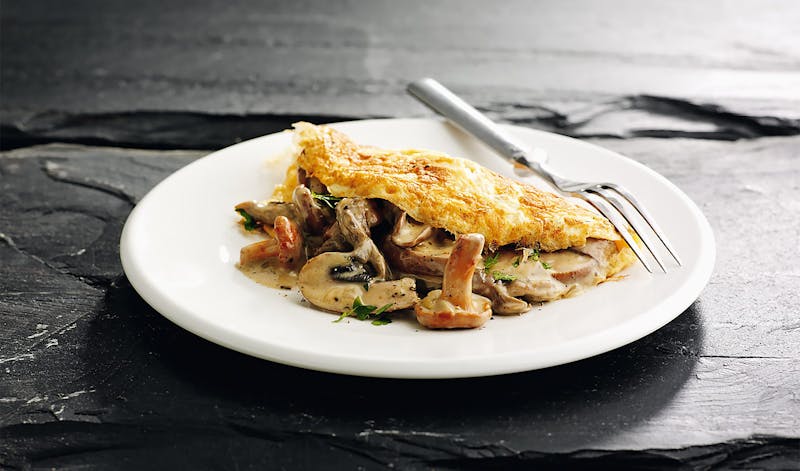
Breakfast is a great time to eat low-carb foods. Who doesn't love bacon & eggs? And there are so many more options – delicious, fast or both.
Here are some of our low-carb breakfast favorites, followed by other fantastic options:
Other basic low-carb breakfasts
- Leftovers from last night's dinner
- Coffee with cream
- A can of mackerel and boiled eggs
- Avocado, salmon and sour cream
- Cheese with butter
- Boiled eggs mashed with butter, chopped chives, salt and pepper
- A piece of brie cheese and some ham or salami (or a full breakfast tapas plate)
- High-fat yoghurt with nuts and seeds (and perhaps berries)
The no-breakfast option
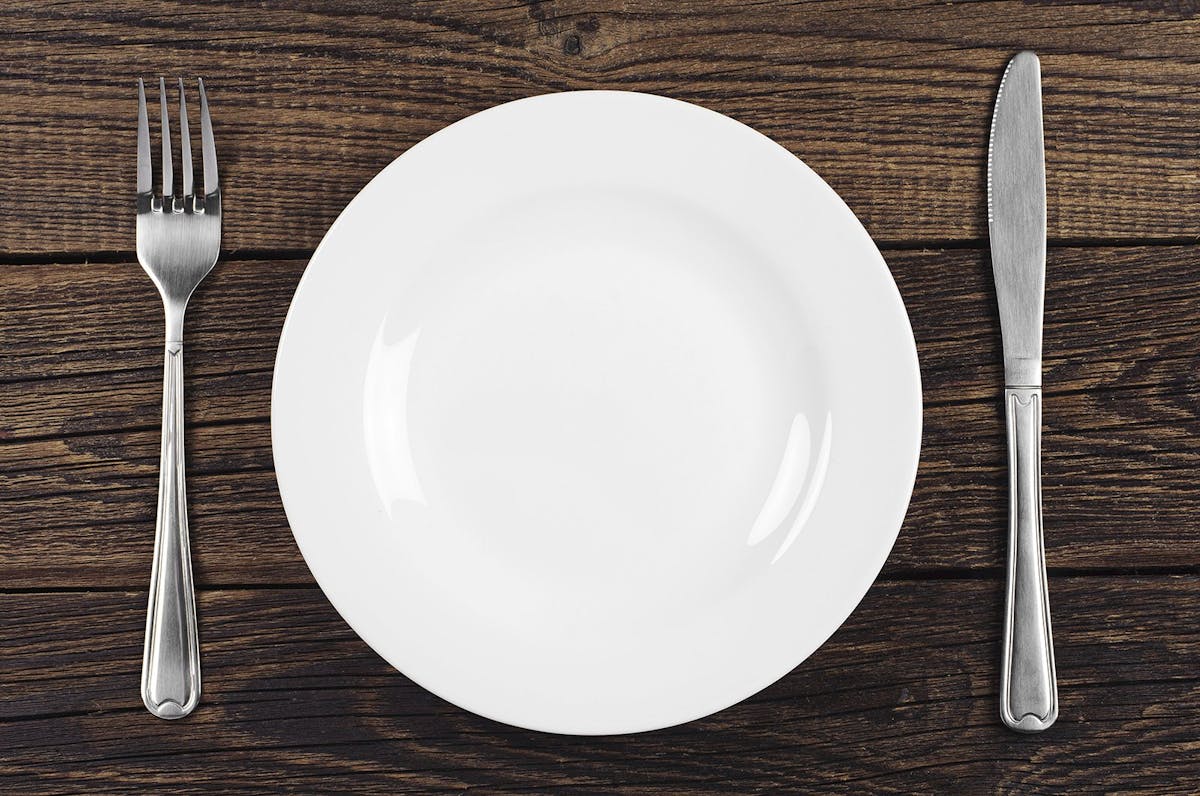 Do you NEED breakfast on a low-carb diet? No.44
Do you NEED breakfast on a low-carb diet? No.44
On a low-carb, high-fat diet you're likely not as hungry and you don't need to eat as often.45 Skipping breakfast is perfectly fine if you're not hungry. Perhaps you'll only have a cup of coffee.
In fact, skipping breakfast is a popular version of intermittent fasting. This can speed up weight loss… and likely type 2 diabetes reversal.46 As a bonus you can save time and money.
Are you feeling brave enough to skip breakfast?
Learn more about intermittent fasting
Recipes
Instead of potatoes, rice and pasta
There are many ways to replace potatoes, pasta and rice with vegetables, resulting in far fewer carbs. Here are a few of the most popular options.
All low-carb side dishes
Other simple sides
- Salads made from above-ground vegetables, perhaps with some kind of cheese. Try out different kinds.
- Boiled broccoli, cauliflower or Brussels sprouts.
- Vegetables au gratin: Fry squash, aubergine and fennel (or other vegetables you like) in butter. Add salt and pepper. Put in baking dish and add grated cheese. Bake at 225° C (450° F) until the cheese melts and turns golden.
- Vegetables stewed in cream, e.g. cabbage or spinach.
- Avocado
- Vegetable spaghetti can be used instead of pasta. Try it
Dining out or meals with friends
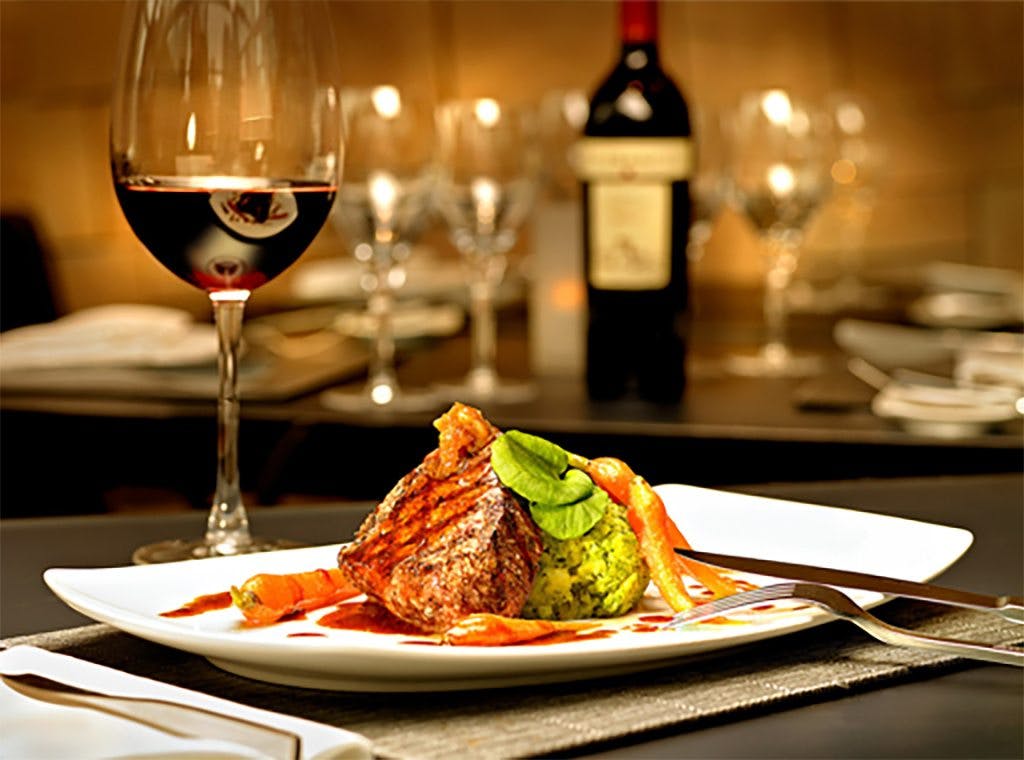
- Restaurants: Usually not a big problem. You can ask to replace potatoes or fries with a salad or low-carb vegetables.
- Fast food: Doner kebab or other meat or chicken kebab can be a decent option (avoid the bread). At hamburger chains the hamburgers (without the bun) are usually the least bad option. Avoid soft drinks and fries, obviously. Drink water or unsweetened iced tea. Pizza toppings are usually OK. Simply remove from the crust and enjoy.
- Nuts or cheese are good "emergency food" when there are no other low-carb options to be found. Remember to ask they leave the crackers out, possibly substituting walnuts or almonds, you may even get more cheese!
- If you eat strictly everyday it's less of a problem to make a few exceptions when you are invited out. If you're not sure what will be served you can eat something at home before you leave.
6. Low-carb snacks and desserts
On a low-carbohydrate diet with more protein and a little extra fat you will probably not need to eat as often. Don't be surprised if you no longer need to snack. Many people do well eating two or three meals per day and nothing in between.47
If you always get hungry between meals you're probably not eating enough protein. Try increasing protein first before adding more fat. Don't fear them.48 If you are getting adequate amounts of protein and fiber-filled veggies, then eat more calories from fat until you feel satisfied.49
Here are quick options if you want to eat something right away:
- Rolled-up cheese or ham with a vegetable (some people even spread butter on cheese)
- A piece of cheese
- A boiled egg from the refrigerator
- Canned mackerel in tomato sauce
- Cheese cubes
Snacks
Olives and nuts may replace potato chips as snacks. Here are more low-carb food options:
- Mixed nuts Learn more
- Sausage: Cut it in pieces, add a piece of cheese and stick a toothpick through them.50 You may want to check the nutrition label for the carb content of the sausages. Some are made cheaper by adding in starchy carbs instead of meat.
- Vegetables with dip, Try cucumber sticks, red, yellow or green peppers, cauliflower, etc. More
- Cream cheese rolls: Spread some cream cheese on a piece of salami, prosciutto/cold cuts or a long slice of cucumber; then roll it up.
- Olives
- Parmesan cheese crisps: On a baking tray, form small piles of grated Parmesan cheese. Heat in oven at 225°C (450°F). Let them melt until they turn a nice color (be careful – they burn easily). Serve as chips, perhaps with some dip.
Visual low-carb guides
Snack recipes
Dessert recipes
8. Q&A
Here are common questions about low-carb foods. For other low-carb questions, feel free to use our full low-carb FAQ.
I don't eat meat, or I don't eat dairy. Can I still eat low carb?
Yes. Just eat other low-carb foods. You can even eat a vegetarian low-carb diet, or a dairy-free low-carb diet, so it's absolutely possible.
Can I eat fruit on a low-carb diet?
You can eat fruit in moderation, and your best bet is berries. Fruit contains a lot of sugar (it's nature's candy).
How much fruit you can eat mainly depends on how many carbs you're aiming for. If you're targeting below 20 grams daily, for a strict low-carb diet (probably the most effective version for weight loss and type 2 diabetes reversal), you will have to enjoy fruit in smaller amounts and only occasionally.
On a more moderate or liberal low-carb diet, let's say 75 grams of carbs per day, you could eat a serving or two of fruit most days. Learn more in our full low-carb fruits guide
Can I drink alcohol on a low-carb diet?
Yes. But make sure to drink low-carb things, like dry wine or whiskey. Full low-carb alcohol guide
More

A low-carb diet for beginners
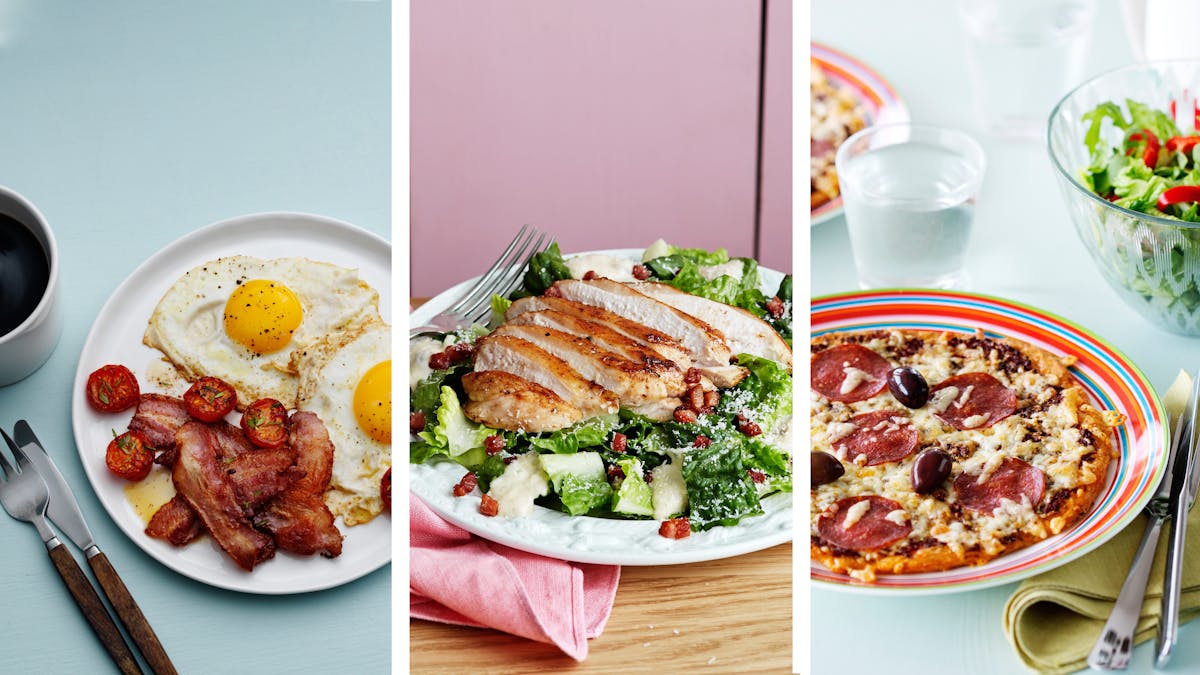
14-day low-carb diet meal plan
More recipes
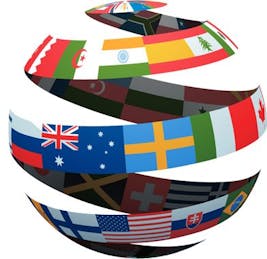
Advice on low-carb foods in 40 languages
We have written advice on a low-carb, high-fat diet in 40 languages. Note especially that we have two more Diet Doctor sites in other languages, with this guide in Spanish or Swedish.
More
Next
Keep reading about how low carb works
Good Carbs for a Low Carb Diet
Source: https://www.dietdoctor.com/low-carb/foods